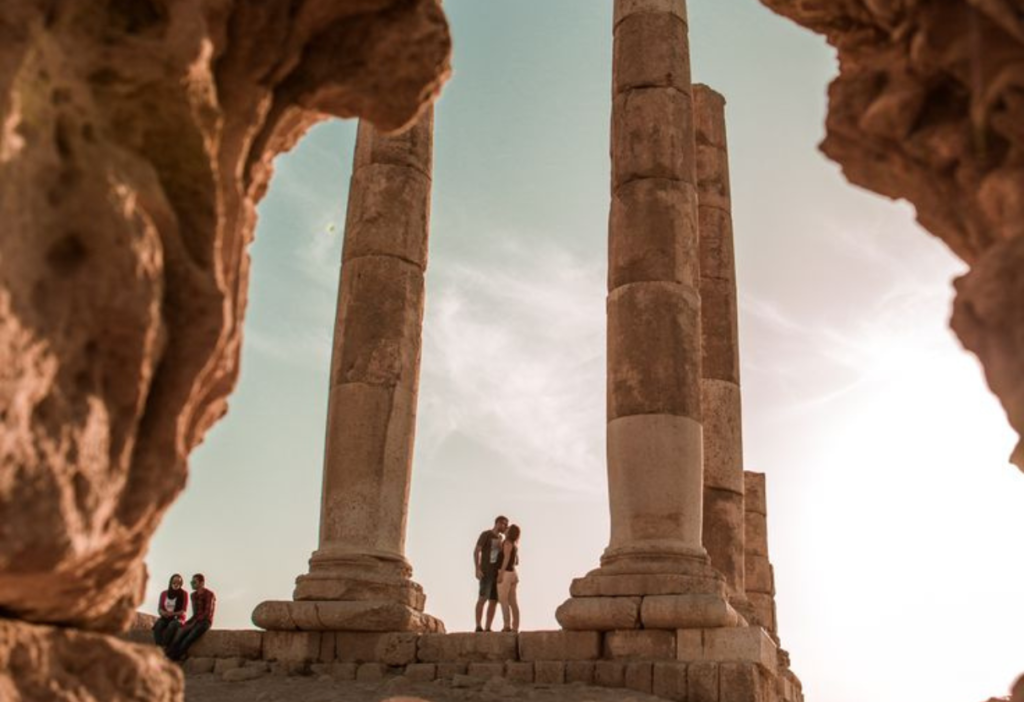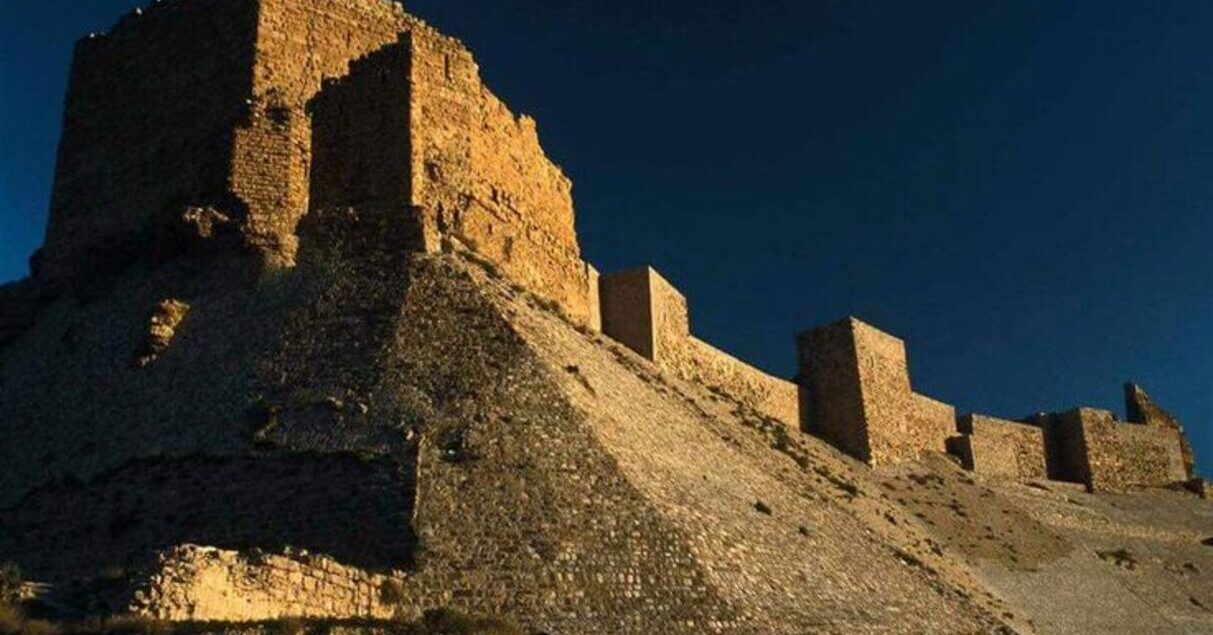Palaces in Jordan: A Guide to the Country’s Most Spectacular Royal Residences
Palaces in Jordan are a testament to the country’s rich history and cultural heritage. Jordan’s palaces showcase the architectural styles of various periods, from the Roman and Byzantine to the Islamic eras. Some of these palaces have been restored to their former glory, while others remain in ruins, but all of them offer a glimpse into the country’s past.

Image credit: Voyagefox Pinterest
One of the most famous palaces in Jordan is the Qasr Amra, a UNESCO World Heritage Site. This 8th-century palace is located in the eastern desert of Jordan and is renowned for its stunning frescoes, which depict scenes from daily life, hunting, and astronomy. Another notable palace is the Qasr Kharana, which dates back to the 7th century and is believed to have been a resting place for traders and travelers. Its unique architecture and design make it a popular tourist attraction.
Jordan’s palaces are not just historical landmarks, but they also serve as a reminder of the country’s cultural diversity. From the Umayyad palaces to the Ottoman-era buildings, each palace has its own unique story to tell. Whether you’re a history buff or just looking to explore the country’s rich cultural heritage, a visit to Jordan’s palaces is a must.
Historical Context of Jordanian Palaces

Image credit: Hayley & Kyle Pinterest
As you explore the palaces of Jordan, it is important to understand the historical context in which they were built. Jordan’s rich history and diverse cultural influences have shaped the architecture and design of its palaces.
During the Islamic Golden Age, Jordan was a centre of learning and culture. Many palaces were built during this time, including the Umayyad Palace in Jerash. This palace was constructed in the 8th century and features a mix of Roman and Islamic architectural styles.
In the 19th century, Jordan was part of the Ottoman Empire. Ottoman influence can be seen in the design of many palaces, such as the Qasr Al-Mushatta. This palace was built in the 8th century and features intricate geometric patterns and calligraphy.
Another significant period in Jordanian history was the British Mandate era, which lasted from 1920 to 1946. During this time, many palaces were built in the Art Deco style, such as the Al-Hussein Palace in Amman.
Today, Jordan’s palaces continue to showcase its rich cultural heritage. Whether you are exploring the ancient Umayyad Palace or the modern Al-Hussein Palace, you will be struck by the beauty and diversity of Jordan’s architectural styles.
Famous Palaces in Jordan
Jordan is a country that is rich in history and culture, and one of the best ways to experience this is by visiting its famous palaces. Here are some of the most notable palaces in Jordan that you should consider visiting:
Raghadan Palace
Located in the capital city of Amman, Raghadan Palace is the official residence of the King of Jordan. The palace is known for its stunning architecture, which blends traditional Arabic and modern styles. The palace is surrounded by beautiful gardens and is a popular tourist attraction.
Basman Palace
Basman Palace is located in the city of Irbid, in the northern part of Jordan. The palace was built in the early 20th century and was used as a royal residence until the 1950s. Today, the palace is open to the public and is home to a museum that showcases the history of the palace and the surrounding area.
Al-Maquar Palace
Al-Maquar Palace is located in the town of Al-Maquar, in the southern part of Jordan. The palace was built in the 19th century and was used as a residence by the Ottoman governor of the region. Today, the palace is open to the public and is a popular tourist attraction.
Zahran Palace
Zahran Palace is located in the city of Amman and was built in the early 20th century. The palace was used as a residence by King Talal and his family until the 1960s. Today, the palace is open to the public and is home to a museum that showcases the history of the palace and its former residents.
Visiting these palaces is a great way to experience the rich history and culture of Jordan. Whether you are interested in architecture, history, or simply want to explore the country’s cultural heritage, these palaces are definitely worth a visit.
Architectural Styles and Influences

Image credit: Celia Albaladejo Gómez Pinterest
Jordan’s palaces showcase a blend of architectural styles and influences from various periods. These styles and influences have been shaped by the country’s rich history and cultural diversity.
One of the most prominent architectural styles seen in Jordan’s palaces is Islamic architecture, which is characterized by geometric patterns, domes, and arches. This style can be seen in the Al-Qasr Palace, which was built in the 8th century during the Umayyad period.
Another influence on Jordan’s palaces is the Ottoman Empire, which ruled the country from the 16th to the early 20th century. Ottoman architecture is characterized by large domes, ornate decorations, and intricate tile work. This style can be seen in the Al-Husseini Palace, which was built in the early 20th century.
In addition to Islamic and Ottoman influences, Jordan’s palaces also showcase European architectural styles. This is evident in the Al-Mahatta Palace, which was built in the early 20th century and features a mix of European and Islamic architectural elements.
Overall, Jordan’s palaces offer a unique blend of architectural styles and influences that reflect the country’s rich history and cultural diversity.
Cultural Significance of Palaces
Palaces in Jordan hold a significant cultural value that reflects the country’s history and heritage. These grand structures were built by the ruling monarchs and served as their residence and a symbol of power and wealth. They were also used for official ceremonies and events, showcasing the country’s culture and traditions.
The architectural style of the palaces is a blend of Islamic, Ottoman, and European influences, reflecting the country’s diverse cultural heritage. The intricate designs, ornate decorations, and exquisite craftsmanship of the palaces are a testament to the skilled artisans and craftsmen who built them.
Palaces also played a pivotal role in the political and social landscape of Jordan. They were used to host foreign dignitaries and heads of states, strengthening diplomatic ties and promoting cultural exchange. They were also a hub for cultural activities, including music, dance, and art, providing a platform for local artists to showcase their talents.
Today, many of the palaces have been converted into museums, showcasing the country’s rich history and culture. They serve as a reminder of Jordan’s glorious past and the enduring legacy of its rulers. Visiting these palaces is a unique opportunity to experience the country’s rich cultural heritage and learn about its history and traditions.
In conclusion, palaces in Jordan are not just grand structures but an integral part of the country’s cultural heritage. They embody the country’s rich history and traditions and serve as a testament to its enduring legacy.
Conservation and Tourism

Image credit: Viva La Vita Pinterest
When it comes to preserving the cultural heritage of Jordan, the country takes its responsibility seriously. The palaces in Jordan are no exception, and their conservation is a top priority for the government.
In recent years, the government has invested heavily in the restoration and preservation of the palaces, with the goal of ensuring that future generations can appreciate and learn from these important historical landmarks. This effort has been aided by the support of various international organizations and donors.
Tourism is also an important aspect of the conservation of palaces in Jordan. The revenue generated from tourism helps to fund the ongoing preservation efforts, ensuring that the palaces remain in good condition for years to come.
Visitors to Jordan can enjoy guided tours of the palaces, which provide an opportunity to learn about the history and culture of the country. The tours are led by knowledgeable guides who are passionate about sharing their knowledge with visitors.
In addition to tours, visitors can also participate in cultural events and activities that take place at the palaces. These events provide a unique opportunity to experience Jordanian culture up close and personal.
Overall, the conservation of palaces in Jordan is a testament to the country’s commitment to preserving its rich cultural heritage. Through responsible tourism and ongoing preservation efforts, these important landmarks will continue to inspire and educate visitors for generations to come.
Frequently Asked Questions

Image credit: Lighthouse Photography Pinterest
What is the significance of Raghadan Palace in Jordan’s history?
Raghadan Palace is a significant landmark in Jordan’s history as it serves as the official residence of the King of Jordan. The palace was built in 1926 and has since been the site of many important events, including the signing of peace treaties and the welcoming of foreign dignitaries.
How many royal residences are there in Jordan?
There are several royal residences in Jordan, including Raghadan Palace, Zahran Palace, Al-Maquar Palace, and Al Husseiniya Palace. Each palace serves a different purpose, ranging from official state functions to private residences for members of the royal family.
Where is the official residence of the King of Jordan located?
The official residence of the King of Jordan is located in Raghadan Palace, which is situated in the capital city of Amman. The palace is a grand and impressive structure that is well-known throughout the country.
Can you visit Al Husseiniya Palace, and what can tourists expect to see?
Al Husseiniya Palace is not open to the public, as it is a private residence for members of the royal family. However, visitors can still admire the palace from the outside and take in its impressive architecture and beautiful surroundings.
What role does Al-Maquar Palace play in the Jordanian monarchy?
Al-Maquar Palace is an important part of the Jordanian monarchy, as it serves as a residence for members of the royal family. The palace is also used for official state functions and events, as well as private gatherings and celebrations.
Who are the members of the Jordanian royal family currently residing in Zahran Palace?
Zahran Palace is currently home to several members of the Jordanian royal family, including Prince Hamzah bin Al Hussein and Princess Badiya bint El Hassan. The palace is a beautiful and historic residence that is well worth a visit for those interested in Jordanian history and culture.
Jordan latest travel updates: US, AU , CA , UK
